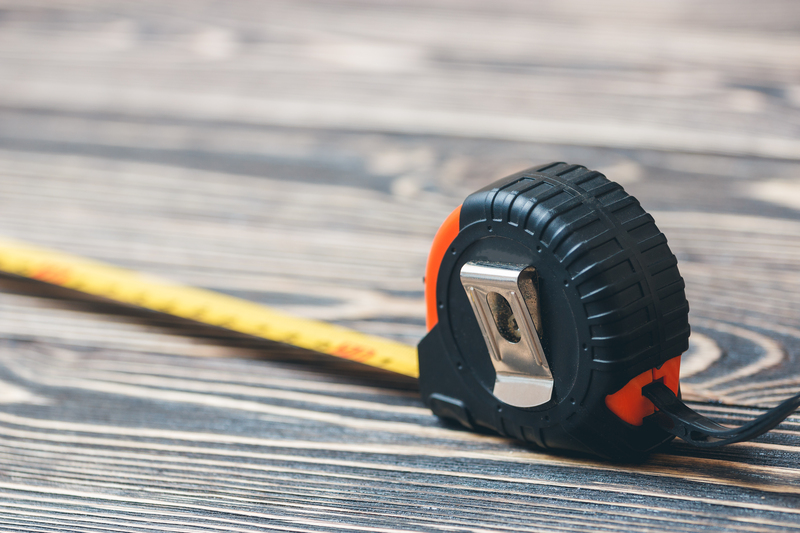Storage Solutions for a Freezer Not in Regular Use
Posted on 24/06/2025
Storage Solutions for a Freezer Not in Regular Use
If you have a freezer that's not in regular use, you might wonder about the best way to keep it clean, efficient, and ready for action when needed. Whether it's a chest, upright, or small portable freezer, careful storage and occasional maintenance are crucial. In this comprehensive guide, we'll delve into imaginative, practical, and effective storage solutions for a freezer not in regular use, discussing everything from cleaning and prepping to location and power-saving tips.
Why Proper Storage for an Unused Freezer Matters
A freezer that's seldom used but improperly stored can become more of a headache than a convenience. Common issues include mold growth, musty odors, rust, power wastage, and even mechanical failure. By implementing effective storage strategies for your under-utilized freezer, you can:
- Prolong its lifespan
- Ensure hygiene and food safety
- Save on energy costs
- Retain flexibility for emergencies or bulk storage
Understanding how to store a freezer not in regular use can make a significant difference in its functionality and longevity.

Preparing Your Freezer for Infrequent Use
1. Thorough Cleaning and Defrosting
Before putting your freezer into periods of inactivity, it's essential to clean and defrost it. Follow these steps for the best results:
- Unplug the freezer and remove all items.
- Allow any ice buildup to melt, placing towels to absorb the water.
- Use a mild soap or specialized appliance cleaner to wipe down all surfaces.
- Rinse thoroughly with clean water and dry completely, especially around the gasket and seams.
Tip: Leave the freezer door open after cleaning - this prevents odors and stops mold from forming.
2. Ensure the Freezer Is Completely Dry
Moisture is the enemy of any unused freezer. After cleaning, let the freezer air dry for several hours with the door open. You can place a small fan blowing into the unit or use absorbent materials like silica gel packs or baking soda to capture residual moisture.
Best Storage Locations for a Freezer Not in Use
Your choice of storage location significantly affects how your inactive freezer will fare during periods of non-use. Here are some of the top locations and tips for each:
- Garage or Basement: Ensure the area is dry, free of temperature extremes, and has good ventilation.
- Utility Room: Keep it away from water heaters or other heat sources to prevent unnecessary wear.
- Spare Room or Laundry: Ideal if you want quick access - make sure the floor can support the freezer's weight.
- Outdoor Sheds: Only suitable if well insulated and protected from weather; otherwise, avoid due to humidity and temperature swings.
Key Consideration: Never store a freezer outside or in an unheated environment if you live in a region with harsh weather or high humidity.
Preparing the Location
- Level the floor to prevent strain on the compressor and door seals.
- Place the freezer on a raised platform (like a wooden pallet) to avoid direct contact with concrete, which can attract condensation and rust.
- Check for rodent or pest entry points and seal them to avoid infestations.
To Plug In or Unplug? Keeping Your Idle Freezer Safe
Deciding whether to keep your unused freezer plugged in depends on how soon you anticipate using it again.
- If you're storing it for just a few weeks: It's often better to keep it plugged in and running empty. Use minimal power settings and place a couple of water bottles for temperature balance.
- For storage over months: Unplug, clean, and always leave the door slightly ajar to prevent odors and mold buildup.
Remember: A closed, unplugged freezer is a prime environment for mold and bacteria growth. Use a prop or wedge to keep the door slightly open.
Organizing the Interior: Smart Storage Tactics
Prevent Inside Odors and Moisture Build-up
- Place a box of baking soda or activated charcoal inside to absorb odors.
- Leave a clean, dry towel inside to catch any unexpected moisture.
- Use storage bins or containers if you plan to keep any non-food items inside.
Use Your Idle Freezer for Alternative Storage
An unused freezer can double as secure storage for many household items that benefit from a cool, dry, and rodent-free environment. Consider the following:
- Grains or pet food (in sealed, insect-proof containers)
- Emergency preparedness items like backup batteries, candles, or first aid kits (in waterproof bins)
- Seasonal kitchenware or infrequently used cooking gadgets (protect in plastic containers)
Warning: Never store chemicals, paints, or flammable items inside your freezer, regardless of use status.
Maintenance Tips for a Freezer Not in Regular Service
Monthly Quick Check
To ensure your dormant freezer remains in good condition:
- Open the door for a few minutes to air out the unit and prevent stale odors.
- Inspect for any signs of mold, rust, or pests.
- Replace or refresh odor absorbers, like baking soda or silica packs.
Annual Deep Clean and Inspection
- Pull the freezer out from the wall and vacuum coils and rear vents to prevent dust buildup (improves efficiency when in use).
- Check gaskets and door seals for cracks or degradation.
- Clean all internal surfaces with vinegar or a mild sanitizer before closing it up for another period of disuse.
Protecting the Exterior of the Unused Freezer
Don't forget the outside of your non-active freezer. Protect it with these tips:
- Wipe down exterior surfaces regularly to prevent dust and stains.
- Cover it loosely with a breathable cloth or appliance cover to shield from direct sunlight and debris.
- Ensure air vents and compressor areas are unobstructed for when you resume use.
Safety Considerations: Preventing Accidents
A freezer not in regular use can become a hazard if not managed properly, especially if it's accessible to children. Always:
- Secure the lid or door with a lock or heavy-duty strap if the unit is located in a shared space or garage.
- Remove or disable the internal latch mechanism on old freezers to prevent accidental entrapment.
- Label the outside with a note: "Unplugged - Do Not Open" during storage to avoid confusion.
When It's Time to Use Your Freezer Again
After months or even years, when you're ready to bring your temporarily stored freezer back into service, follow these steps:
- Remove any odor-absorbing agents or storage containers.
- Wipe the interior and exterior with a clean, damp cloth.
- Check the door seal for adequacy and elasticity.
- Plug in the freezer and let it reach the proper temperature before loading any new food.
If you notice any persistent odors, mildew, or unusual noises, perform a more thorough cleaning or consult a professional for inspection.
Energy Efficient Solutions for Long-Term Inactive Freezers
If you anticipate multiple cycles of regular and irregular use, investing in an energy-efficient model can pay dividends. Here are some ideas:
- Choose models with automatic moisture controls and self-defrost options.
- Look for the Energy Star label for better power management during standby.
- Use appliance timers or smart plugs that can help you program occasional "on" cycles for air circulation and prevent mustiness.
Regular Power Cycling: Pros and Cons
- Pro: Occasional running keeps compressors lubricated and seals tight.
- Con: Increased power usage if not monitored; may not be practical for rarely used appliances.
Frequently Asked Questions (FAQs)
-
Can you store a freezer unplugged without damaging it?
Yes, as long as the freezer is clean, dry, and the door is left open to prevent mold, storing unplugged will not harm the appliance. -
Is it better to leave my freezer running empty?
Only if you expect to use it again soon. Otherwise, unplug and prep according to storage guidelines to save energy. -
What's the best way to keep the freezer odor-free during storage?
Use baking soda, silica packs, or activated charcoal, and leave the door ajar. -
What should I avoid storing inside an idle freezer?
Never store hazardous chemicals, wet items, or food unprotected from rodents.

Summing Up: Best Practices for Storing a Freezer Not in Regular Use
Successfully storing a freezer out of regular use is all about cleanliness, ventilation, and security. Prepare in advance, choose the right spot, and keep it dry and odor-free. By following these storage solutions for a freezer not in use, you'll ensure your appliance is always ready to serve you without hiccups or unpleasant surprises.
- Clean, dry, and prop the door open to prevent mold.
- Store only safe, suitable items inside.
- Inspect regularly for maintenance.
Whether you rotate between freezers or keep one as a backup, these strategies will keep your unit efficient and trouble-free, maximizing your investment and peace of mind.
Related Resources
- Learn how to buy an energy-saving freezer
- Check manufacturer manuals for your specific model's storage requirements
- For extensive downtime, consider professional cleaning or servicing.
For more expert advice on home appliance care, bookmark this guide and revisit whenever you need a refresher on clever storage solutions for a freezer not in regular use!



